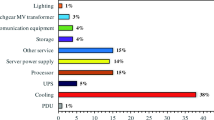Abstract
A two-phase loop thermosyphon (TPLT) is an apparatus for heat transmission from the hot section of system (evaporator) to the cold part (condenser), with relatively small temperature differences. The setup used in this study consists of a TPLT, including evaporator, riser, an advanced condenser and downcomer. The condenser inlet has a nozzle. The steam rises from evaporator, flows through the nozzle and sprays on a vertical copper surface inside the condenser. To cool the copper sheet, then a cooler system was installed rear of it. The experimental tests were performed for presence of the nozzle and without it. The results showed that the TPLT efficiency increases for the modified condenser using nozzle. Also, the overall heat transfer coefficient of TPLT is enhanced by the nozzle. In the case of the nozzle with distance of 13 mm from copper sheet, and T e,sat > 55 °C, the value of \(\bar{h}_{c}\) suddenly increased.










Similar content being viewed by others
Abbreviations
- A c :
-
Area of vertical copper sheet in the condenser, m2
- A e :
-
Area of heat transfer surface in the evaporator, m2
- C p,c :
-
Specific heat for water cooler, J/Kg-K
- C p,h :
-
Specific heat for water heater, J/Kg-K
- \(\bar{h}_{c}\) :
-
Mean heat transfer coefficient in the condenser, W/m2-K
- h e :
-
Experimental heat transfer coefficient in the evaporator, W/m2-K
- \(\dot{m}_{w,c}\) :
-
Mass flow rate of the water cooler, Kg/s
- \(\dot{m}_{w,h}\) :
-
Mass flow rate of the water heater, Kg/s
- M :
-
Molecular weight, Kg/Kmol
- P :
-
Water working fluid pressure, Pa
- P cr,water :
-
Water critical pressure, Pa
- P e,sat :
-
Dry steam outlet pressure of the evaporator, Pa
- pr :
-
Reduced pressure (pr = P e,sat /P cr,water )
- Q in :
-
Heat input in the evaporator, W
- Q out :
-
Heat output in the condenser, W
- q :
-
Heat flux, W/m2
- T h,i :
-
Water heater inlet temperature, °C
- T h,o :
-
Water heater outlet temperature, °C
- T c,sat :
-
Dry steam inlet temperature of the condenser, °C
- T e,sat :
-
Dry steam outlet temperature of the evaporator, °C
- T w,i :
-
Water cooler inlet temperature, °C
- T w,o :
-
Water cooler outlet temperature, °C
- T wall,c :
-
Average temperature of the wall in the condenser copper sheet, °C
- T wall,e :
-
Average temperature of the wall in the evaporator, °C
References
Ziapour BM (2009) Performance analysis of an enhanced thermosyphon Rankine cycle using impulse turbine. Energy 34:1636–1641
Qu W (2010) Hydrodynamics of two-phase loop thermosyphon. Front Heat Pipes 1(2):1–7
Kusaba S, Suzuki H, Hirowatari K et al (2000) Extraction of geothermal energy and electric power generation using a large scale heat pipe. In: proceeding of WGC 2000, pp 3489–3494
Chang SW, Lo DC, Chiang KF, Lin CY (2012) Sub-atmospheric boiling heat transfer and thermal performance of two-phase loop thermosyphon. Exp Therm Fluid Sci 39:134–147
He J, Lin G, Bai L et al (2013) Effect of non-condensable gas on startup of a loop thermosyphon. Int J Therm sci 72:184–194
Yang XF, Liu ZH (2012) Flow boiling heat transfer in the evaporator of a loop thermosyphon operating with CUO based aqueous nanofluid. Int J Heat Mass Transf 55:7375–7384
Franco A, Filippeschi S (2013) Experimental analysis of closed loop two phase thermosyphon (CLTPT) for energy systems. Exp Therm Fluid Sci 51:302–311
Khodabandeh R, Palm B (2002) Influence of system pressure on the boiling heat transfer coefficient in a closed two-phase thermosyphon loop. Int J Therm sci 41:619–624
Aung NZ, Li S (2013) Numerical investigation on effect of riser diameter and inclination on system parameters in a two-phase closed loop thermosyphon solar water heater. Energy Convers Manag 75:25–35
Khodabandeh R, Furberg R (2010) Instability, heat transfer and flow regime in a two phase thermosyphon loop at different diameter evaporator channel. Appl Therm Eng 30:1107–1114
Ziapour BM, Shaker H (2010) Exergetic analysis of a long two-phase closed thermosyphon system. Int J Exergy 7:714–730
Mochizuki M et al (1994) A Performance of loop-type heat pipe having showering nozzles. In: proceeding of 8th IHPC, pp 448–451
Zuckerman N, Lior N (2006) Jet impingement heat transfer: physics, correlations, and numerical modeling. Adv Heat Transf 39:565–631
Cooper MG (1984) Heat flow rates in saturated nucleate pool boiling—a wide ranging examination using reduced properties. In: Hartnett JP, Irvine TF Jr (eds) Advances in heat transfer, vol 16. Academic Press, Orlando
Author information
Authors and Affiliations
Corresponding author
Rights and permissions
About this article
Cite this article
Ziapour, B.M., Baygan, M. & Mohammadnia, A. Experimental study on the performance characteristics of an enhanced two-phase loop thermosyphon. Heat Mass Transfer 51, 1487–1492 (2015). https://doi.org/10.1007/s00231-015-1518-2
Received:
Accepted:
Published:
Issue Date:
DOI: https://doi.org/10.1007/s00231-015-1518-2




